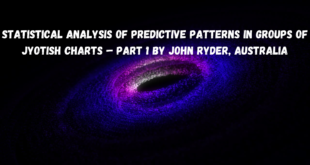Related Articles
SA Volunteer: Manish Gour
‘Taken with permission from The Astrological Magazine: March, 1977
As MANY people do not clearly know the terms and 0ther matters occurring in a Panchanga, they are explained below :— Panchanga is a necessity for every Hindu for casting of horoscopes for astrological purposes and for the observance of his daily religious rites. Each rite begins with a preamble called Sankalpa. In the Sankalpa reference is made to vara, tithi, nakshatra, yoga and karana. These are ths five principal parts (pancha angas) of the Indian Almanac, which is therefore called Panchanga.
The Vara
Vara or week-day is common to both the Indian and Western almanacs. We are inclined to believe that the actual naming of the days of the week in the present order was done by the ancient Hindu astronomers. They arranged the five planets (known at that time) and the Sun and the Moon in the order of decrease of the periodic times of their circuit of the heavens, viz., Saturn, Jupiter, Mars, the Sun, Venus, Mercury and the Moon. The day was divided by them into 24 parts called Horas (hours). Each hora is associated with a planet or the Sun or the Moon and the horas following each other are named after these bodies in the order in which they are arranged above. If the first hora of a certain day is associated with the Sun, say, the day is named Sunday. The 24th or last hora of the day will be associated with Mercury and the next hora which is the first hora of subsequent day will be associated with the Moon. So the next day is called Monday. The names of the successive days are given in this way and this is the familiar order of Succession of the days of the week.
The Tithi
Tithi is based on the elongation of the Moon from the Sun. The beginning or ending moment of a tithi is the instant at which the longitude of the Moon is in excess of the longitude of the Sun by an integral multiple of 12. There are therefore 30 (360÷12°) tithis from the New Moon to the next New Moon. The first 15 tithis cover the period from the New Moon to the Full Moon referred to as Sukla Paksha (bright fortnight). The remaining 15 tithis cover the period from the Full Moon to the New Moon, known as Krishna Paksha (dark fortnight).
In the Indian almanac the day is reckoned from sunrise to next sunrise. The tithi of a civil day is usually taken to be the tithi current at sunrise on that day. Since the time of sunrise is not the same for all places, it is to be noted that occasionally a tithi current at sunrise at one place may not be current at sunrise at another place. It is also possible for a particular tithi to be current at sunrise on two successive days. So two consecutive days may have the same tithi associated with them. It is also likely that a tithi may begin after sunrise and end before the next sunrise. In such a case, the tithi will be skipped over. As lunar month of 30 tithis is about 29½ days, the average duration of a tithi is less than one day and hence more tithis are dropped than repeated.
In Hindu Astronomy the geocentric longitudes of planets and the Sun and the Moon are measured from a fixed point on the Ecliptic called Meshadi, whereas in the Western system the longitudes are measured from the true Equinox of date. (This true Equinox called Vernal Equinox or First Point of Aries has a very slow retrograde motion of aboat 50¼” per year. Thus the origin of European Astronomy is this moving point whereas that of the Hindus is a fixed point. Hence in Hindu Astronomy we get a fixed starry background, which is not the case with the Western system. Hence Hindu Astrology is superior to the Western astrology.) The longitude of Meshadi (of Hindus) or in other words the distance of this Meshadi from the First Point of Aries (moving) is known as Ayanamsa. The Hindu longitude is got from the western by subtracting Ayanamsa from it.
The names of the tithis are derived from the words for numbers 1 to 15. Prathama is the first tithi, dviteeya is the second and so on. When the longitude of the Moon=longitude of the Sun + m. 180° =n. then (i) if m =0, it is Sukla Paksha and m = 1, it is Krishna Paksha and (ii) it is ending of the nth tithi, n = 1, 2, …..14. When n = 15, m= 0 it is Full Moon (Pournima) and when n = 15, m = 1 it is New Moon (Amavasya).
Nakshatra
The moon’s path lies within the zodiacal belt which is the region of the celestial sphere extending to 8° on either side of the Ecliptic, the Sun’s apparent path. The Moon completes a circuit of its path with respect to the earth in 27 1/3 days. Hence the Hindu Atronomers divided the zodiacal belt into 27 equal parts called Nakshatras. The word Nakshatra literally means a star. The name given to each of the 27 regions mentioned above was probably taken after a prominent star in the region or in its vicinity. Not all the stars have been clearly identified. The starting point of these 27 regions in Meshadi and it is clear that each region has longitudinal extension of 13° 20’ (= 360° ÷ 27).
The name of the region occupied by the Moon at any instant is itself called the nakshatra at that instant, which is essentially obtained by noting the Nirayana longitude of the Moon at that instant. The names of the 27 nakshatras are (1) Aswini, (2) Bharani, (3) Krittika…… and so one. When the Nirayana longitude of the Moon is n x 13° 20’, the nth nakshatra ends and n + 1th begins (n = 1, 2……..26). If n= 0 the 27th nakshatra ends and the first one begins.
Yoga
Yoga (derived from the root yuj to join) is determined by the sum of the Nirayana longitudes of the Sun and the Moon reduced to module 360°. Just as the nakshatras, the yogas are also 27 in number. If the sum of the Nirayana longitudes of the Sun and the Moon is n x 13° 20’ (n = 1, 2, ….. 26) we get the ending of the nth yoga and beginning of the (n ÷ 1)th; when n = 0 it is the ending of 27th yoga and beginning of the first. The names of the yogas are Vishkambha, Preeti, etc. The yoga may serve as a check for the tithi and nakshatra.
The Karana
Karanas are halves of tithis and so a karana ends (or begins) when the Moon’s longitude minus the Sun’s longitude (= x°) is an integral multiple of 6°. There are 60 karanas (= 30 x 20 or 360° – 56) in a lunar month. Of these 4 are called fixed (sthira) karanas and seven (chara) karanas, repeated 8 times. The fixed karanas are Sakuni, Chatushapada, Nagava, Kimstugna. Sakuni begins when x =342° and ends when x = 348°; Chatushpada begins when x = 348° and ends when x = 354°; Nagava begins when x = 354° and ends when x = 0°; Kimstugna begins when x = 0 and ends when x = 6°; when x = (7 m ÷ n) x 6 (m =0, 1, 2…..7), he (n-a)th karana end and nth begins n = 2, 3, 4, 5, 6. If n = 0 the 6th karana ends and 7th begins when n = 1, the 7th ends and 1st begins. The 7 chara karanas in order are (1) Bava, (2) Balava, (3) Kaulava, (4) Taitula, (5) Gara, (6) Vanija and (7) Vishti (Bhadra).
It is clear that tithis and karanas do not depend on the Ayanamsa, whereas nakshatra depends on it.
In the Panchanga, the ending months of tithis, nakshatras, yogas and karanas are given. Usually the unit of time is one ghatikas. One day of 24 hours = 60 ghatikas (or naligas) and so each ghatikas = 24 minutes. A ghatikas = 60vighatikas (or vinadis) and so vighatika (or vinadi) = 24 seconds.
Many people mistake vinadi for a second and only recentlythis mistake was rectified in All India Radio. (The author pointed out this in 1969 in his lecture “On time” to all the participant teachers, who attended the orientation course in mathematics conducted at the premises of Thiagarajar Engineering College, Madurai.)
Nowadays most Panchangas give the timealso in hours and minutes I.S.T. which can be used throughout India and Sri Lanka and with necessary corrections for other countries.
Months
The Panchanga generally uses both solar and lunar months.
The zodiacal belt is divided into 12 equal parts each extending by 30° of longitude. These parts are called rasis or signs of the zodiac. They are: (1) Mesha (Aries-0°-30°); (2) Vrishabha (Taurus-30° to 60°); (3) Mithuna (Gemini-60° to 90°); (4) Karkataka (Cancer-90° to 120°); (5) Simha (Leo-120° to 150°); (6) Kanya (Virgo-150° to 180°); (7) Thula (Libra-180° to 210°); (8) Vrischika (Scorpio-210° to 240°); (9) Dhanus (Sagittarius-240° to 270°); (10) Makara (Capricorn-270° to 300°); (11) Kumbha (Aquarius-300° to 330°); (12) Meena (Pisces-330° to 360°).
The entry of the Sun into a Rasi is called a Sankramana or Sankranti. The entry of the Sun into Makara (Capricorn) is called the Sankranti and this day is very important for the South Indians. The Sun’s stay in a Rasi is called a solar month and is named after the particular Rasi.
It is to be noted the number of days in a solar month is not the same every year. It may differ by one day. In South India, if the Sun’s entry into a Rasi occurs during daytime (from sunrise to next sunset), then that day is taken as the first of that solar month; whereas if the entry of the Sun happens in night time (i.e., after sunset and before next sunrise) then the subsequent day is taken as the first of that month. (There are slight variations in this rule in other places.) So the year will consist of 365 days or 366 days, normally once in 4 years. We know that Pope Gregory XIII introduced the ingenious correction that is in vogue now, viz., if the number of a year is divisible by 4, it is a leap year containing 29 days in February, except a century year which is a leap year only when it is divisible by 400. Even this brilliant correction we find that 400 Gregorian years exceed 400 tropical years by 400 x 365 ÷ 97 – 400 x 365.2422 or 0.12 of a day and hence in spite of the marvelous correction of Gregory, the difference stated will be one day in about 3400 years and it is left to posterity to tackle this problem.
Now we admire the master-mind of the ancient Hindus who gave the simple rule for fixing the first date of each month by which we clearly see that there is no accumulation of any error whereas in the present Gregorian system some genius in future has to find way out of the excess of -12 day in 400 years.
Lunar Months
The lunar month is the interval between two successive New Moons or Full Moons. If, as is mostly used, the lunar month ends with the New Moon (Amavasya), it is called Amanta and when it is considered as ending with the Full Moon, it is known as Pournimanta.
The lunar months are named after 12 of the 27 stars, which are nearly equidistant. Each lunar month is linked with a solar month, as its name is determined by the Sankranti occurring in it as shown in the annexed table here. These are the 12 stars at or near which the respective Full Moons occur in most of the years.
Name of Sankranti | Name of lunar month in which the Sankranti occurs |
Mesha | Chaitra |
Vrishabha | Vaisakha |
Mithuna | Jyeshta |
Karkataka | Ashada |
Simha | Sravana |
Kanya | Bhadrapada |
Thula | Aswayuja |
Vrischika | Kartika |
Dhanus | Margasira |
Makara | Pushya |
Kumbha | Magha |
Meena | Phalguna |
It is possible that in a particular lunar month there may not be a Sankranti. For, two successive New Moons may occur while the Sun is in a particular Rasi. This phenomenon occurs once in 3 or 4 years. Such a lunar month is called Adhika (or extra) and its name is the same as that of the succeeding lunar month, using the prefix Adhika, whereas the name of the next lunar month has the prefix Jija.
It is also likely that two Sankrantis may occur in a particular lunar month which means that no New Moon will occur as the Sun passes through the particular Rasi. It must be noted that though the Rasis are equally spaced, the time taken by the Sun tomove through each of them is not the same. In such a case there will be a gap in the sequence of the names of the lunar months. In 1963, no New Moon occurred when the Sun passed through Vrischika Rasi. So the lunar month following Kartika was Pushya. Here Margasira month is said to be suppressed or kshaya. The period of recurrence of such gaps varies from 19 years to 141 years.
The six solar months Tai to Ani belong to Uttarayana (i.e., the Sun in the North) and the remaining six solar months are Dakshinayana (i.e., the Sun in the South).
Again the year is divided into six Ritus (seasons). Chaitra and Vaisakha constitute Vasanta Ritu and so on.
Other Items
In addition to the above, a Panchanga usually contains the following items:-
Yogini directions depending upon tithi. For travel, if yogini is right or back it is good; akasha and earth are madhyama (i.e., fair); and left or front it is bad.
Amrutadi Yogas (amruta, siddha, utpada, prabalarishta and marana) depend upon the Nakshatra and vara (day). Of the five yogas stated above, the first two are good and the rest bad.
Nakshatra Tyajya is for 4 ghatikas or 1 hour 36 minutes from the moment shown and this period is considered to be inauspicious.
Netra and Jiva upon the nakshatra and the Sun’s position. 2, 1 are respectively good; 1, ½ fair and 0 are bad.
The times when planets retrograde (i.e., appear to people on earth to be moving in the reverse direction) and when they become direct are also given. These are useful in Astrology.
The balance in Rasi is given for everyday which will be of help in finding Lagna, the Rasi cutting the eastern horizon at any given time.
The important festivals and vratas are also given in a Panchanga at the appropriate places.
The time of entry of the planets and the Sun in each wuarter of a nakshatra are given which are useful in casting a horoscope giving Rasi, Navamsa and Drekkana.
The times of sunrise and sunset for each day for the place for which the Panchanga is calculated are also given. As the sunrise and sunset are not the same for all days and for all places, we have to apply what is known as Desantara Samskara to the timings given in ghatikas and vighatikas as (time in hours, minutes I.S.T – require no correction).
Heliacal rising and setting of planets (Mercury, Venus, Mars, Jupiter and Saturn) are also given. A planet will remain invisible to the naked eye (due to its proximity to the Sun) during the period from heliacal setting to heliacal rising.
In a Panchanga details are also given regarding the solar and lunar eclipses occurring in that year in that locality. The Siddhanta Panchanga also give the circumstances of the eclipsesas per Drig system.
In a Panchanga they also give the names of the portfolios given to the planets in the planetary cabinet and their effects are also indicated.
To facilitate the layman to understand the list containing the names in Sanskrit (with English equivalents wherever possible) are given below:-
Days of the week:- Ravivara-Sunday; Somavara-Monday; Mangalavara-Tuesday; Budhavara-Wednesday; Guruvara-Thursday; Sukravara-Friday; Sanivara-Saturday.
Planets:- Surya-Sun; Chandr-Moon; Kuja-Mars; Budha-Mercury; Guru-jupiter; Sukra-Venus; Sani-saturn; Rahu-ascending node of the Moon’s orbit; Ketu-descending node of the Moon’s orbit.
Nakshatras:- 1. Aswini, 2. Bharani, 3. Krittika, 4. Rohini, 5. Mrugasira, 6. Ardra, 7. Punarvasu, 8. Pushya, 9. Aslesha, 10. Makha, 11. Poorvaphalguni, 12. Uttaraphalguni, 13. Hasta, 14. Chitra, 15. Swati, 16. Visakha, 17. Anuradha, 18. Jyeshta, 19. Moola, 20. Poorvashadha, 21. Uttatashadha, 22. Sravana, 23. Dhanishta, 24. Satabhisha, 25. Poorvabhadrapada, 26. Uttarabhadrapada, 27. Revati.
Yogas:- 1. Vishkambha, 2. Preeti, 3. Ayushman, 4. Soubhagya, 5. Shobhana, 6. Atiganda, 7. Sukarma, 8. Dhruti, 9. Soola, 10. Ganda, 11. Vriddhi, 12. Dhruva, 13. Vyaghata, 14. Hatshana, 15. Vajra, 16. Siddhi, 17. Vyateepata, 18. Variyan, 19. Parigha, 20. Siva, 21. Siddha, 22. Sadhya, 23. Subha, 24. Subhra, 25. Brahmya, 26. Indra, 27. Vaidhruti.
Ritus:- 1. Chaitra and Vaisakha-Vasanta Ritu; 2. Jyeshta and Ashadha-Greeshma Ritu; 3. Sravana and Bhadrapada-Varsha Ritu; 4. Aswayuja and Kartika-Saras Ritu; 5. Margasira and Pushya-Hemanta Ritu; 6. Magha and Phalguna-Sisira Ritu.
Thithis:- 1. Prathama-first; 2. Dviteeya-second; 3. Triteeya-third; 4. Chaturthi-fourth; 5. Panchami-fifth; 6. Shashti-sixth; 7. Saptami-sevent; 8. Ashtami-eighth; 9. Navami-ninth; 10. Dasami-tenth; 11. Ekadasi-eleventh; 12. Dwadasi-twelfth; 13. Trayodasi-thirteenth; 14. Chaturdasi-fourteenth tithi; Pournami-Full Moon; Amavasya-New Moon.
Learn Astrology: Join Our Upcoming Astrology Classes — Click Here
Learn Astrology: Join Our Recorded Astrology Classes — Click Here
 Saptarishis Astrology Magazine Into Creating Astrologers
Saptarishis Astrology Magazine Into Creating Astrologers






